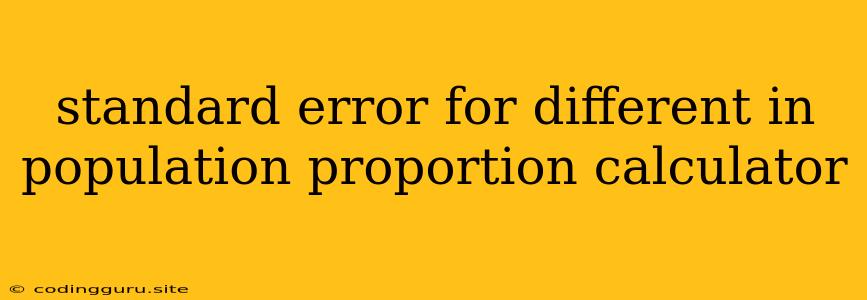Understanding the Standard Error for Difference in Population Proportions
When comparing two populations, you might want to determine if there's a statistically significant difference between the proportions of a specific characteristic in each population. This is where the standard error for the difference in population proportions comes into play.
What is the Standard Error for Difference in Population Proportions?
The standard error for the difference in population proportions is a measure of the variability of the difference between two sample proportions. In simpler terms, it tells us how much the difference between the sample proportions might vary from the true difference between the population proportions.
Why is this Important?
Understanding the standard error helps us make informed conclusions about the difference between population proportions. For instance, if the standard error is large, the difference between the sample proportions might not be significant enough to conclude a true difference in the populations. Conversely, a small standard error suggests a more precise estimate of the difference between the population proportions.
How to Calculate the Standard Error?
The formula to calculate the standard error for the difference in population proportions is:
SE = sqrt[(p1(1-p1)/n1) + (p2(1-p2)/n2)]
where:
- SE is the standard error.
- p1 is the sample proportion for the first population.
- p2 is the sample proportion for the second population.
- n1 is the sample size for the first population.
- n2 is the sample size for the second population.
Example: Calculating the Standard Error
Imagine you are comparing the proportion of people who prefer tea in two different cities.
- In City A, 60 out of 100 people prefer tea (p1 = 0.6, n1 = 100).
- In City B, 40 out of 150 people prefer tea (p2 = 0.27, n2 = 150).
To calculate the standard error, we plug these values into the formula:
SE = sqrt[(0.6(1-0.6)/100) + (0.27(1-0.27)/150)]
SE = sqrt[0.0024 + 0.0013]
SE ≈ 0.063
Therefore, the standard error for the difference in population proportions is approximately 0.063.
Using the Standard Error for Hypothesis Testing
The standard error for the difference in population proportions is crucial when performing hypothesis testing. It helps determine if the observed difference in sample proportions is statistically significant or simply due to random chance.
Key Takeaways:
- The standard error for the difference in population proportions is a measure of the variability of the difference between two sample proportions.
- A larger standard error indicates greater uncertainty about the true difference between the population proportions.
- A smaller standard error suggests a more precise estimate of the difference.
- The standard error is essential for hypothesis testing to determine if observed differences are statistically significant.
Conclusion:
The standard error for the difference in population proportions plays a vital role in comparing two populations. It provides a measure of uncertainty and helps us determine the reliability of the observed difference between sample proportions. By understanding and calculating the standard error, researchers and analysts can draw more accurate conclusions about the true differences between populations.
